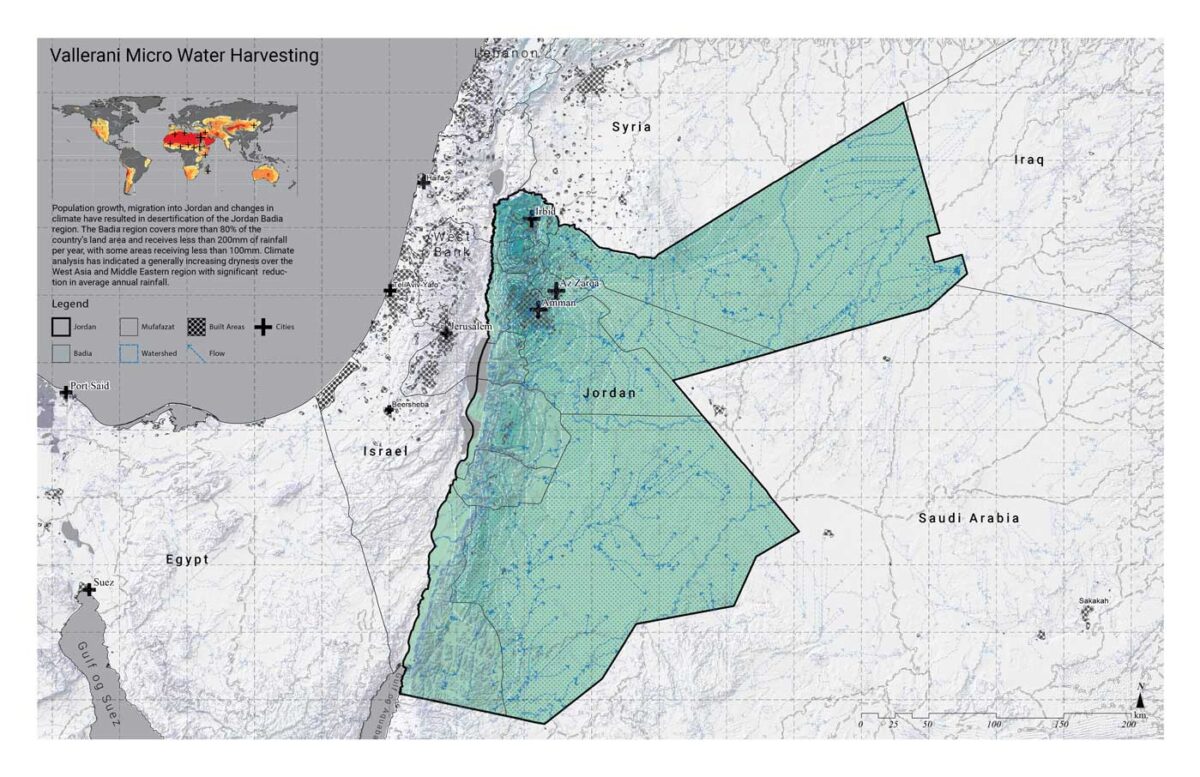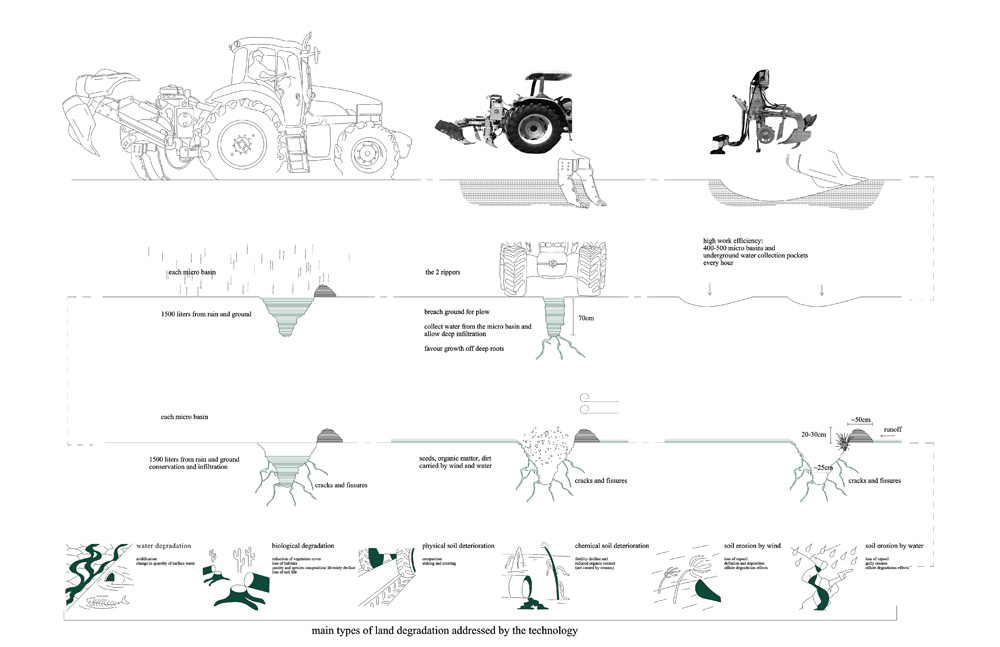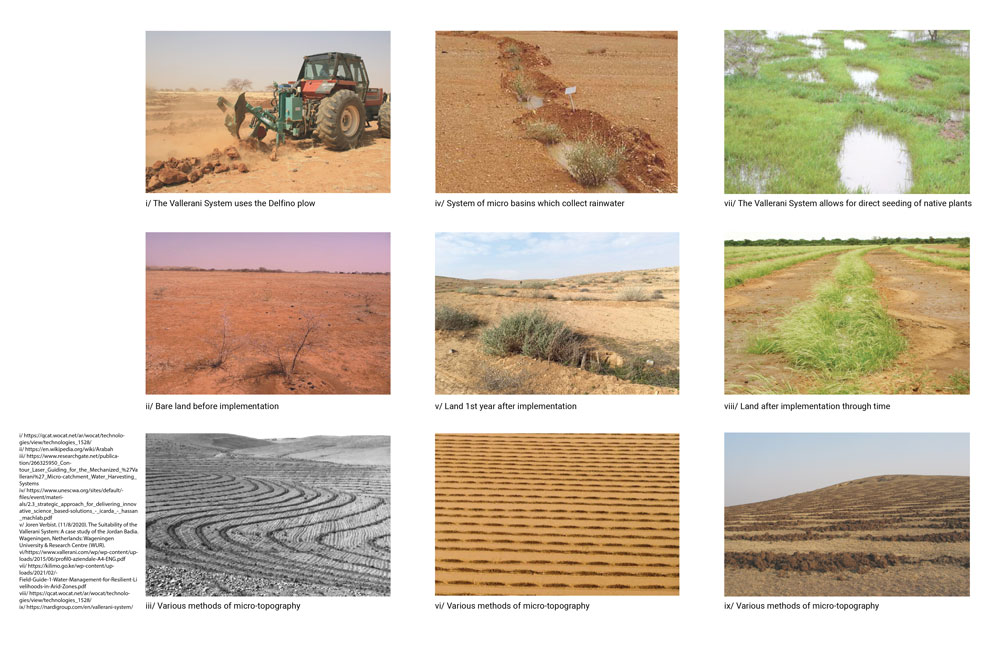Vallerani Micro Water Harvesting

Vallerani Micro Water Harvesting, Badia Region, Jordan, 1996–ongoing. Realized/Envisioned by ICARDA. Scale: 494210 acres. 3000 feet above sea level. Drawing: Caroline Koh Smith, Hang Guo, Petch Peewsook.
The Badia Region covers more than 80% of Jordan and receives less than 8 inches of rain per year, a number that has been decreasing due to climate change. Livestock herding, as well as deep ploughing and barley planting, have caused severe land degradation and the depletion of rangeland resources, including grasses. The diversity of plants throughout the Badia Region has declined, and introduced species have a low nutritional value. The soils across the region are crusted, resulting in a low water infiltration rate, sheet runoff, and erosion and gullying that can result in downstream flooding in Jordan’s capital, Amman. A microharvesting rainwater plan was developed using the Vallerani microharvesting technique to restore the desertified Badia. The technique uses the Vallerani plough, in which a tractor digs small water harvesting pits on the contours of hillside slopes, creating water retention and infiltration of surface runoff. These micro-catchments are planted with native shrub seedlings that are drought and salt-tolerant, which serve as fodder for livestock. The system catches an additional 12 inches of water yearly, which allows for the production of crops at a small scale, as well as livestock production that supports local needs at a relatively low cost of $32-116 per hectare. The micro-harvesting technique has been used across the world in Burkina Faso, Chad, China, Egypt, Kenya, Madagascar, Morocco, Niger, Senegal, Syria, Sudan, and Tunisia, as well as in Jordan. The implementation of Vallerani projects focuses on capacity building local stakeholders and farmers who can maintain the results of the mechanized system by caring for plants and developing local markets.
References
Whitman, Elizabeth. “A Land without Water: The Scramble to Stop Jordan from Running Dry.” Nature News. September 04, 2019. Accessed July 6, 2020. https://www.nature.com/articles/d41586-019-02600-w.
Ali, Akhtar, Theib Oweis, Atef Abdul Aal, Mohamed Mudabbar, Khaled Zubaidi, and Adriana Bruggeman. “The Vallerani Water Harvesting System.” ICARDA Caravan 23 (2006): 13.
Gammoh, Issa & Oweis, Theib. “Performance and Adaptation of the Vallerani Mechanized Water Harvesting System in Degraded Badia Rangelands.” Journal of Environmental Science, Computer Science and Engineering & Technology 5 (2011): 1370-1380.
Abel, Guy J., Michael Brottrager, Jesus Crespo Cuaresma, and Raya Muttarak. “Climate, conflict and forced migration.” Global Environmental Change 54 (2019): 239-249.
Rawajfih, J. “Arid soils of the Badia region of northeastern Jordan: potential use for sustainable agriculture.” Archives of Agronomy and Soil Science 51, no. 1 (2005): 25-32.
Links
“Vallerani Micro Water Harvesting,” ICARDA, November 9, 2019.

